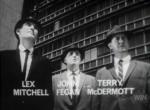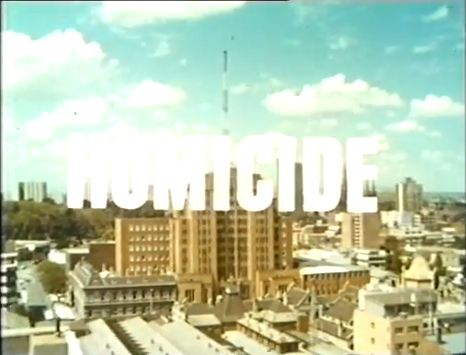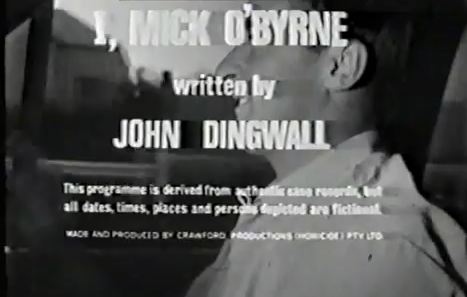AustLit
-
Homicide (1964-1977)
In 1964, Inspector Jack Connolly (John Fegan), Detective Sergeant Frank Bronson (Terry McDermott), and Detective Rex Fraser (Lex Mitchell) stepped through the front doors of the magnificent Art Deco police station on Melbourne's Russell Street–and history was made.
With episode one of Australia's first successful locally made television drama, Crawford Productions began their long domination of Australian television.
In 2013, Dr Catriona Mills undertook a research fellowship with the AFI Research Collection at RMIT to bring their collection of early Crawford Productions scripts together with AustLit. The result was records for 318 episodes of Crawfords radio and television dramas, including 61 episodes of Homicide.
What follows is a collection of resources relating to Homicide, divided into five parts.
Part one showcases AustLit's own records for Homicide and for the people and companies responsible for its production.
Part two explores one aspect of the relationship between Homicide and true crime.
Part three begins to map the staff involved Crawford Productions.
Part four traces two elements of Homicide's life beyond the weekly serial: radio and telemovies.
Part five dips into the actual episodes themselves, with Australian Screen's collection of Homicide film clips.
-
See full AustLit entry
Hector Crawford Productions (later Crawford Productions) was founded in 1945 by brother-and-sister team Hector and Dorothy Crawford.
First located in Little Collins Street, the company moved as it expanded, first to Collins Street, then out into Abbotsford, and eventually to the studios at Box Hill (demolished in 2006).
With their mutual background and interest in music, Dorothy and Hector's early productions were often music based, such as Music for the People (live concerts in the Melbourne Botanical Gardens, conducted by Hector, and broadcast live on radio).
Explore AustLit's record for the production company behind Homicide.
-
See full AustLit entry
Born in Melbourne to Henry William Crawford (a commercial salesman) and Charlotte Tuner (a contralto and organist), Hector Crawford studied at the Melbourne Conservatorium of Music, where he was also the conductor.
In 1940, he joined the Broadcast Exchange of Australia as its he became the musical and recording director: by 1942, he was its managing director in 1942. In 1944, his sister Dorothy, who had been working at the Australian Broadcasting Commission (ABC) as an announcer, joined him at the Broadcast Exchange of Australia.
Explore AustLit's detailed record for Hector Crawford.
-
See full AustLit entry
Born in Melbourne to Henry William Crawford (a commerical salesman) and Charlotte Tuner (a contralto and organist), Dorothy Crawford was educated at schools in Fitzroy and St Kilda before graduating from the Albert Street Conservatorium, East Melbourne, in voice and piano.
Married in 1931, Crawford continued to pursue her career, working as an actress in radio dramas from the 1930s. In 1942, she joined the Australian Broadcasting Commission (ABC) as one of their first three female announcers in Victoria: according to the Australian Dictionary of Biography, 'As the ABC’s policy was not to employ married women, she kept her marriage and child secret.
Explore AustLit's detailed record for Dorothy Crawford.
-
 The original cast of Homicide (screen cap)See full AustLit entry
The original cast of Homicide (screen cap)See full AustLit entryRunning for twelve years and a total of 510 episodes, Homicide was a seminal Australian police-procedural program, set in the homicide squad of the Victoria Police. According to Don Storey in his Classic Australian Television, it represented a turning point for Australian television, prompting the development of local productions over the purchase of relatively inexpensive American dramas. Indeed, Storey quotes Hector Crawford as saying that his production company intended three outcomes from Homicide: demonstrating that it was possible to make a high-quality local drama series, counteracting criticism of local performers, and showing that Australian audiences would watch Australian-made dramas.
(...more)Explored AustLit's record for Homicide, including the records for more than sixty individual episodes.
-
The Last Man Hanged
On the 8th of July 1969, Homicide aired the episode 'I, Mick O'Byrne'. Written by John Dingwall, the episode bore a marked similarity to the escape, recapture, and subsequent execution of Ronald Ryan, the last man hanged in Australia.
In 1964, Ronald Ryan received an eight-year prison sentence for breaking and entering, and was incarcerated in Pentridge Prison. In 1965, he escaped with a fellow prisoner: in the course of the escape, warder George Hodson was shot dead. The escapees were recaptured nineteen days later. Ryan was put on trial for the murder of Hodson in March 1966, found guilty and sentenced to death, and hanged in February 1967.
As the last man hanged in Australia, Ronald Ryan has continued to fascinate Australian writers. See the range of works written about him here.
-
 Screen cap from opening creditsSee full AustLit entry
Screen cap from opening creditsSee full AustLit entryThe script (which follows the escape and subsequent re-capture of two Pentridge prisoners) bears a strong resemblance to the events surrounding the escape from Pentridge Prison of Ronald Ryan and Peter Walker and the subsequent execution of Ryan.
The script held in the Crawford Collection in the AFI Research Collection contains the following character notes (excluding regular characters):
'MICHAEL XAVIER O'BYRNE Early 40's, preferably not tall, medium build, must be active.
(...more)See AustLit's detailed record for this episode of Homicide.
-
The following section explores the role of staff members in Crawford Productions' expansion from early radio days to one of Australia's most prominent television production companies.
Begin with an interview with Ian Crawford, a second-generation member of a family company. Then examine the role of script-writer, by exploring AustLit's own record for Everett De Roche, before reading his interview with Spectacular Optical on how he came to work with Crawfords and why he stopped. Then follow the link to the Crawford Productions' tribute website for an overview of how many staff contributed to the running of the company.
-
Among the treasures nestled on Don Storey's website about classic Australian television is an interview with Ian Crawford, second generation Crawford Productions staff member. Follow this link below to see the full interview.
'An Interview with Ian Crawford', Classic Australian Television, 2004. (Sighted: 12/11/2013)
-
See full AustLit entry
Prolific script-writer Everett De Roche was born in Lincoln, Maine (United States), in what he describes in his interview with Spectacular Optical as 'a tiny town surrounded by lakes and forests. Not far from Stephen King. I think there's an inherent spookiness in Maine that spurs an interest in the Dark Side.' His family moved to San Diego, California, when De Roche was six years old. In 1968, when he was twenty two, he and his wife moved to Australia.
Despite a strong interest in writing as a child and teenager, De Roche had no training in script-writing when he began writing for Australian television, beginning with Crawford Productions in Melbourne.
Explore AustLit's record for one of Crawford Productions' most prolific script-writers.
-
Everett De Roche was not only one of Crawford Productions most prolific script-writers, he is also one of the most prolific script-writers in Australian film and television generally. In this interview, he talks about how he came to Australia from 'a tiny town surrounded by lakes and forests' in Maine, how he wrote pamphlets on venereal disease for government agencies, and how he first came to work for Crawford Productions.
Aaron W. Graham, 'An Interview with Everett De Roche', Spectacular Optical, 1 June 2012.
-
The content of crawfordproductions.tv, a website built in tribute to Crawford Productions from its inception in 1945 to the closure of the Box Hill studios in 2006, covers more than solely the staff who worked for the company. But the website's extraordinary lists of staff names–not solely of producers, script-writers, directors, but of all the roles involved in television production–gives an overview of what it takes to keep a company such as Crawford Productions running.
'Staff Names', crawfordproductions.tv (sighted: 12/11/2013)
-
When we think of Homicide, we think of the discrete weekly episodes that made up the long-running series. But Homicide touched on other forms of media, from those that were dying away when it began to those that were burgeoning as it drew to a close.
The content below covers the reverberations of Homicide beyond the format of weekly episodes, from the program's radio origins to their award-winning telemovie.
-
On 14 August 1951, at 8:30pm on radio station 3DB, Crawford Productions aired the first episode of its new radio series, D24: 'The Case of Youth Hold Up with Stolen Rifle'.
The series drew its name from the name for the Victoria Police Information Bureau, and would run for more than 470 episodes until the final episode, 'The Silent Accusers', aired in December 1960.
As contemporary newspaper articles indicated, the stories of D24 were ripped from the headlines, or, as Alan Nicholls put it in The Argus, were 'a dramatisation of stories from the confidential files of the Criminal Investigation Branch'. The series was, Nicholls emphasises, 'designed to let the public know what the police are doing.'
Ending its run four years before Homicide appeared on the screen, D24 is one of Crawfords' earlier crime dramas.
Explore the following sources for more information on D24.
'Radio by Alan Nicholls', The Argus, 11 August 1951, p.15.
D24 Episode Logs, Australian Old Time Radio (Sighted: 12/11/2013)
D24 at the National Film and Sound Archive (Sighted: 12/11/2013)
-
'From the files of the Victoria Police, for the first time, come these true stories of unceasing war against crime, of day and night vigilance that protects our life and our property, and of the nerve centre of the Police Information Bureau: D24.'
So ran the opening narration of Crawford Productions' D24.
Episode eight of D24 aired on Australian radio on 2 October 1951. Written by Roland Strong, it begins with two men found dead in a taxi outside an abandoned warehouse.
Listen to the entirety of the episode, courtesy of the National Film and Sound Archive's collection, via the link below.
'The Taxi Murders', D24, episode eight (aired 2/10/1951). NFSA Title No: 452167. Available via SoundCloud. (Sighted: 12/11/2013)
-
The Homicide Telemovie: Stopover (1974)
In 1974, Homicide aired a telemovie called Stopover, tracing the involvement of an English rock star in the murder of his rhythm guitarist at an Australian airport. Written by Keith Thompson, the telemovie won an AWGIE Award (Best Writer - TV Play) and three Sammy Awards (Best TV Play, Best Writer - TV Play, and Best Direction - TV).
Stopover's fragile, end-of-the-road rock star Gordon Hayes was played by Jon English. English also provided the music for his alter-ego's band, drawn from his own album, It's All A Game.
The video below shows the closing credits for Stopover, including English's cover of 'Turn the Page', originally written by Bob Seger in 1972.
//www.youtube.com/embed/KREhGEcq6fU?list=PL179DB42EA60C547F -
Australian Screen (ASO) is the educational and promotional resource operated by the National Film and Sound Archive (NFSA). Among its many treasures are clips from seminal Australian films and television series–and among these are three episodes of Homicide.
Explore these episodes below.
-
In this episode of Homicide, an escaped convict is murdered, and the detectives suspect a connection between this death and an unsolved robbery committed years earlier.
'The Decimal Point', Homicide, episode 12. Written by David Baker & Sonia Borg. Directed by Bruce Ross-Smith. First aired on 9 February 1965 in Melbourne.
View the ASO record, including three clips from the original episode, here.
-
In this episode of Homicide, written as a comedy, Senior Detective Jim Patterson's wild twin brother Eddie is in town, and Jim's colleagues are aghast at their mate's seemingly erratic behaviour.
'The Superintendent', Homicide, episode 249. Written by Luis Bayonas. Directed by Alex Emanuel. First aired on 12 May 1970 in Melbourne.
View the ASO record, including three clips from the original episode, here.
-
In this episode of Homicide, a former safe-cracker, now on the straight and narrow, finds himself once again on the wrong side of the law as he helps out a mate.
'The Friendly Fellow', Homicide, episode 385. Written by Fred 'Cul' Cullen. Directed by David Stevens. First aired on 17 July 1973 in Sydney and Brisbane.
View the ASO record, including three clips from the original episode, here.
You might be interested in...








